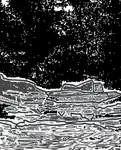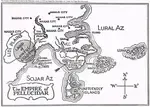Out of... mars?
an analysis of
out of scarlight
by
liz williams
as featured in the anthology old mars
report by dylan jeninga
What to say about this tale? To me it poses the most difficult conundrum of any story in the Old Mars collection. On the one hand, it’s one of the most interesting exercises in world-building to found in the book; on the other hand… is it on Mars? Even after a few rereads, I’m still unsure.
Scarlight sits in a narrow valley, at a point where the Yss river is channeled between steps of stone, and cascades down to the canals of the plains in the series of dramatic chasms. At the top of Scarlight itself, an ancient arched bridge sits over one of these waterfalls, which then plummets several hundred feet to a dark pool, and on down through the town. Scarlight is one of those nexus places, where many roads meet, and they say that the pool is filled with the bones of those who have upset the lords of Scarlight.
Intriguing enough, to my tastes, but the mention of canals is one of the only clues we get that this story is on the fourth planet. The rest of the story would be better described as fantasy than science fiction: in her quest to find her run-off lover, our heroine faces spells and curses and sorcerers.
Certainly, Mars is no stranger to the enigmatic and even apparently supernatural, but almost always, there is at least a tenuous connection to science. Even the angel-analogues in C. S. Lewis’ space trilogy were described as creatures being as physically of this world as we are. Straight-up magic, though, isn’t really part of the Martian character, at least in my experience.
Now, that’s not to say that stories featuring the arcane on Mars are somehow wrong, or that they shouldn’t be written. By all means, write them, and I will read them! In fact, an author could write a story on Mars which rejects everything we know and love about its planetary character, and they wouldn’t be doing anything reproachable. But it wouldn’t feel like Mars.
And that, really, is the only fault I can find with Out of Scarlight. Despite being part of an anthology celebrating our old vision of the red planet, it feels like something new, well done and enjoyable but out of place. One never gets the feeling that “yes, this is Mars, I recognize this, I know the language.” It's a bit like reading a story that’s meant to be set in J.R.R. Tolkien’s Middle Earth, only to find that all of the hobbits have jet packs. (That could actually be really fun. I feel compelled to emphasize again that Scarlight isn’t a bad story, and I don’t regret having read it at all.)
I hope I haven’t given the reader a poor impression of the story. Taken on its own, it presents an intriguing world spiced with a bit of action and mystery. As part of the Old Mars anthology, though, it feels a bit out of place.
{Comment from Zendexor: This raises the big, big issue, of what "is" the "real fictional" Mars. I can just hear the objections of people who miss the point and shrug and say: fictional Mars is unreal anyway and so "why regard any fiction as less appropriate than any other?" Whereas in fact, as Dylan and I and all true OSS fans instinctively realize, our imaginations have combined to create a gestalt which now has a life and validity of its own, so it does make sense to regard it as a real standard. In which case the interesting questions become questions of boundaries, of the form, the extent, the range of this mysterious real-unreality / unreal-reality which comprises OSS Mars and the other characters of worlds in the OSS. Dylan's doubts about the story he discusses here mirror my doubts about Moorcock's Kane of Old Mars trilogy. That's another case of something "not feeling like real Mars", at least in my view, though naturally for different reasons, reflecting the differences in the stories.}





































